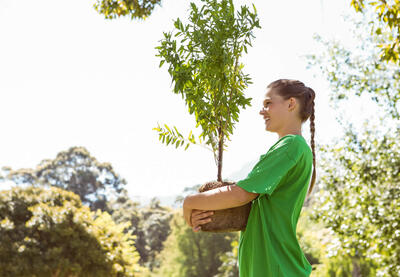There’s been a lot of research lately on the benefits of play and learning in natural environments. Some of this research focuses specifically on school environments. For example, the White Hutchinson Leisure and Learning Group and the National Wildlife Federation (NWF) offer excellent summaries. What this research tells us is that interacting with nature benefits children in all areas of development.
One finding that may be surprising to some relates to nature’s way of fostering positive social interactions and promoting social inclusion. Research by Robin Moore and the Natural Learning Initiative at North Carolina University indicates that children are more cooperative, caring and generous as they play in natural environments. They also show more empathy for other living things, including empathy for each other. This, in turn, can reduce or eliminate anti-social behavior, such as bullying and violence.
Additional research published in the International Journal of Inclusive Education indicates that students’ involvement with nature on school grounds increases self-understanding and interpersonal skills. This research also found that children who work in school gardens are more likely to interact positively with people different from themselves.
Schools can capitalize on what research tells us about the benefits of children’s engagement with natural environments. Fortunately, many schools are already doing this by naturalizing—or “greening”—the school grounds. Results indicate that the efforts are well worth it.
In addition to enhancing the curriculum across all areas of study, naturalized school grounds are also serving as a stimulus for the creation of inclusive communities. One principal noted how parents working in their school garden were adding a whole new dimension to the school’s multicultural education program. Parents from diverse backgrounds were sharing information with the children about the kinds of plants and foods prevalent in their respective cultures.
A special bonding often occurs as children work together on schoolyard gardening projects. This isn’t surprising, as there’s a lot to be done: preparing the soil, planting, watering, weeding and harvesting. These tasks are best accomplished by working together; and at the end of the day, there’s the shared joy and sense of accomplishment.
To naturalize your school grounds, you might start by planting a garden or developing a wildlife habitat. Both have great potential for generating student and community excitement and for bringing people together around a shared goal.
Gardens offer the special benefit of a harvest, which may include both food and flowers. Some schools—in addition to enjoying the harvest themselves—share what they produce with the larger community. Food from the garden is shared with a food bank or other food distribution program and flowers with a senior center or nursing home. This is a nice way for students to get connected with others in the community and to give them practice in sharing.
Resources for gardening with kids are readily available. Here are several helpful websites:
The second idea for naturalizing your school grounds is to establish a wildlife habitat. Most kids love animals and are eager to help them thrive. Establishing a wildlife habitat is an excellent way to involve children in caring for animals. In the process, they also learn to work together. A user-friendly guide on how to develop a schoolyard habitat is available through the NWF. Having your schoolyard habitat certified by the NWF isn’t that hard to do and can be a source of pride for your school.
Once in place, your wildlife habitat will draw a variety of animals to your schoolyard, and the process of creating one can draw different people together in a positive way.
Promoting social inclusion should be a concern of every classroom and school across the nation. Transforming the grounds to connect children with nature helps to transform the school community as well.
Wilson is an educational consultant and curriculum writer.
